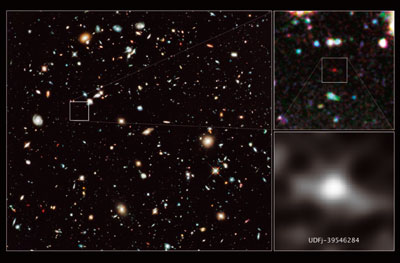
Image credit: NASA, ESA, G Illingworth (University of California, Santa Cruz), R Bouwens (University of California, Santa Cruz, and Leiden University) and the HUDF09 Team.
The Hubble Space Telescope has been pushed to its limits to find a galaxy candidate at a record distance of 13.2 thousand million light-years. The tiny, dim object observed by Hubble could be a compact galaxy of blue stars that is seen as it was only 480 million years after the Big Bang. In addition to the discovery of this galaxy candidate at a redshift, z, of around 10, the study published in Nature shows that the rate of star formation was 10 times lower – at a redshift of z=10 – than it is about 200 million years later, at z=8.
The quest for the most distant object in the universe has reached a legendary milestone: a redshift of 10. The redshift, z, measures the relative shift in the wavelength of light that results from the expansion of the universe during the journey from the remote galaxy to the telescope. It is therefore also a measure of the scale factor of the universe: at a redshift of z=10, distances between the seeds of the massive galaxy clusters of today would have been typically closer to each other by a factor of 1+z=11.
The first claim for a galaxy at a z of around 10 was later disproved (CERN Courier May 2004 p13). In 2006, the record redshift approached z=7 (CERN Courier November 2006 p10), a benchmark that was itself overridden in less than two years (CERN Courier April 2008 p11). In 2003–2004, Hubble accumulated a total exposure of more than 10 days from an apparently empty region in the Fornax constellation. This original Hubble Ultra Deep Field (HUDF) revealed about 10,000 remote galaxies up to z of about 6. After the recent installation of the Wide Field Camera 3 (WFC3), which allows additional infrared measurements, the HUDF was observed again in the summers of 2009 and 2010, offering an unprecedented glimpse of the very first galaxies.
Rychard J Bouwens of Leiden University and the University of California, Santa Cruz, has analysed this unique dataset together with collaborators in Europe and the US. In 2010, based on the first-year data, they published the detection of three galaxies at z of around 8, one of which was confirmed spectroscopically at a redshift of z=8.6 by the European Very Large Telescope. With the addition of the 2010 data, they have now also found a galaxy that would be at z of around 10. The ultraviolet light emitted by this tiny galaxy only one hundredth the size of the Milky Way is measured in the infrared channel at 1.6 μm. It is detected neither at shorter wavelengths because of hydrogen absorption in the early universe, nor by the Spitzer Space Telescope at longer wavelengths – thus excluding a dusty galaxy at lower redshift.
How confident is the team that the faint smudge of light seen in a single channel is not spurious? Bouwens and colleagues first checked that the source is visible in both the 2009 and 2010 datasets, as well as in two random subsets, each containing 50% of the data. Using Monte-Carlo simulations they find a probability of about 80% that the candidate is, indeed, real. Regardless of the uncertainty of this detection the main surprise comes from the fact that this is the only candidate at z around 10. Based on the extrapolation from z=6–7 towards z=10, the team should have found about three galaxies. So, instead of finding an upturn of star formation between z=8 and z=10, there seems to be a downturn in the already decreasing trend of star formation towards higher redshift. It therefore seems that galaxies at z around 10 are not only extremely difficult to observe but are also much less luminous and/or numerous than the galaxies observed later in cosmic time. Galaxies that are less luminous would be expected by a hierarchical growth of galaxies and would better suit Hubble’s successor, the James Webb Space Telescope – scheduled for launch in 2014 – which has a reduced field of view but high sensitivity to faint sources at very high redshift.





